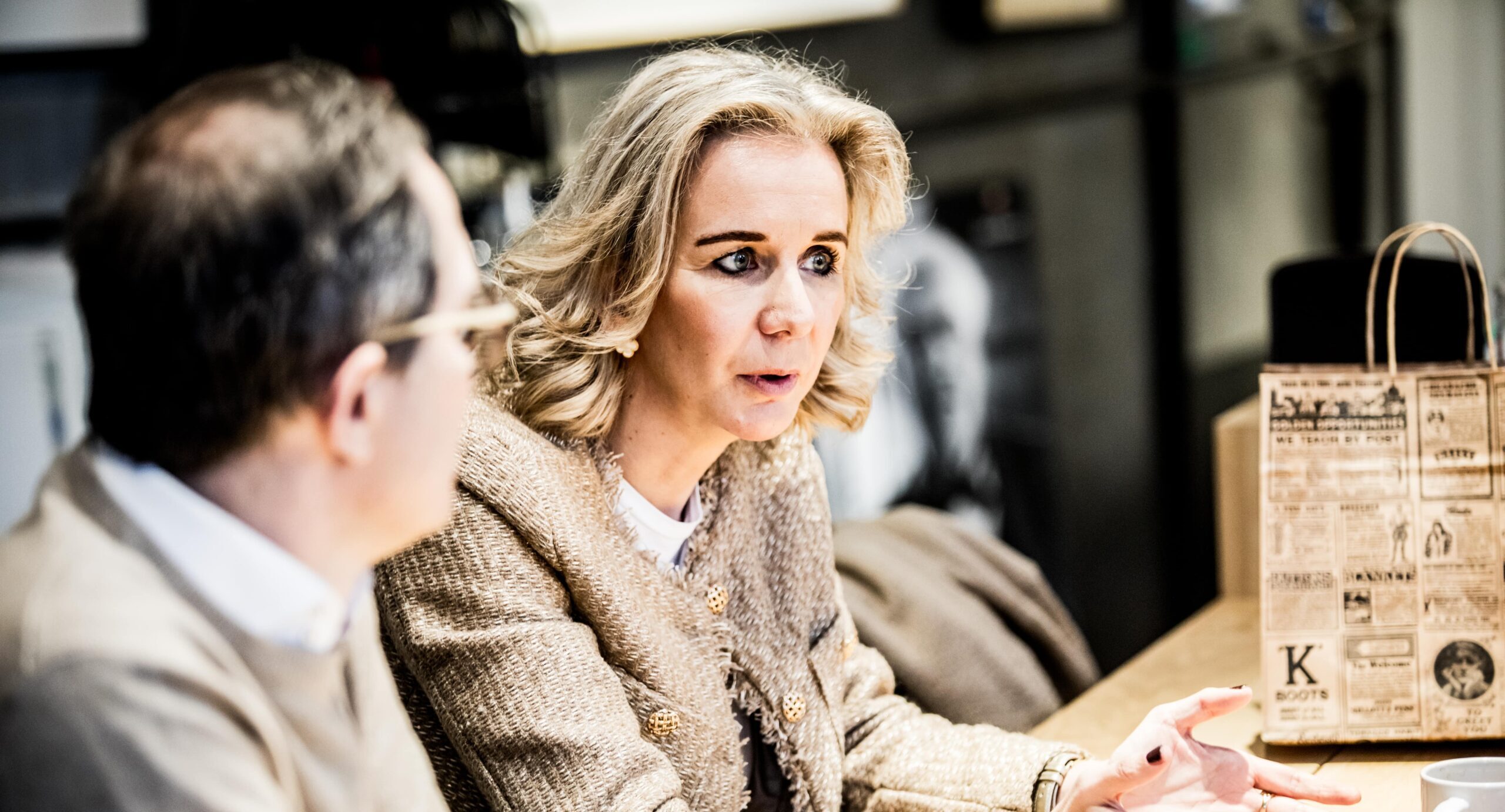
When AI meets AI
What happens when you bring together an entrepreneur with a passion for people with an entrepreneur bitten by technology and innovation? That is what we discover at the conference Ten years of Better Minds at Work where Elke Geraerts and Peter Hinssen combine their insights in a duo keynote: ‘When AI meets AI’. In it, they challenge each other on the potential of artificial intelligence and authentic intelligence. Human versus machine?
Elke Geraerts has a doctorate in psychology and she held several academic positions at the universities of Harvard, St Andrews, Maastricht, Rotterdam and currently at UGent. Ten years ago, she founded Better Minds at Work, which supports companies in their leadership, talent development and mental well-being. From this position, she is a much sought-after keynote speaker. She reaped success with her bestseller Better Minds, in which she helps readers on their way to a more resilient brain. But she wrote other books, including Authentic Intelligence, which was released just before the corona pandemic broke out.
We know Peter Hinssen as a tech guru and visionary on technology, innovation and leadership. He teaches at several business schools such as the London Business School and MIT in Boston. Peter co-founded nexxworks to help organisations thrive in ‘the day after tomorrow’. Consequently, he too travels the world as a keynote speaker throughout the year. It was therefore no easy task to find a time when both were in the country. But it worked and so, between Christmas and New Year, I had an appointment at The Apple Chapel in Mater, where Peter, an avid Apple collector, exhibits all his computers and Apple products. A trip down memory lane, is how he describes it himself. And while Elke and I get a comprehensive tour, outside the first snow is falling …
Uniting artificial and authentic intelligence
Elke: “We find that a lot of companies, executives and employees are concerned and sceptical about artificial intelligence. In my book Authentic Intelligence, I raise just that issue and try to answer the question of where the authenticity and uniqueness of humans lies, what irreplaceable qualities the human brain possesses and what therefore gives humans a competitive advantage over our digital counterparts. The book is actually a search for the raison d’être of our human species in a digital age. The term authentic intelligence is mostly a quip to AI. Remarkably, what makes a human being unique is not yet (enough) on L&D and HR’s radar: our gift to focus and set boundaries, to make deliberate choices rather than being guided by algorithms, and our creativity. At the conference, we want to bring together both worlds – human intelligence and artificial intelligence – based on the belief that they can reinforce each other.”
Peter: “I have been involved with technology for years, but I have never experienced a technology that spread globally as fast as AI. It has also awakened a lot in companies. On the one hand, it’s about acceleration and improvement, but on the other hand, it’s also about the human aspect. The longer I deal with technology, the more I realise that the human aspect can be the limiting factor or the key to success. I used to be mostly asked by the CIO to deliver keynotes on AI, now I am increasingly asked by the CHRO.”
Yesterwork hunters
We need to move faster, act faster and adapt faster, as individuals, as managers, as companies. But Peter wonders if we are moving away from old routines and habits fast enough: “We are fascinated by what is new, but forget to eliminate what is old and outdated. Sticking to outdated processes and systems have a pernicious impact on an organisation’s efficiency and productivity. Yesterwork is what we call it. Steven Van Belleghem, my partner in nexxworks, often talks about friction hunting, by which he refers to a methodology for dramatically improving the customer experience by identifying irritations experienced by customers. It is time for companies to become yesterwork hunters by analogy. When companies bet on digitalisation 20 years ago, it was often by sprinkling a layer of digital over the old way of working. The truth is that companies will only really experience the benefits of AI and other technologies if they dare to fundamentally rethink it and take out all the yesterwork, otherwise you won’t get efficiency. ‘If you want something new, you have to stop doing something old,’ American management professor Peter Drucker once said. That is more relevant than ever.”
“Of course, it’s not just about efficiency,” Elke continues. “Yesterwork not only has a negative impact on operations, it can also be devastating for the psyche of employees. The number of people who are not open to change is high; on the other hand, you also have people who do show open-mindedness and are willing to reinvent themselves. The acceleration of change and negativity in the world can potentially create an even bigger gap between those who can and want to follow, and those who cannot and do not. As an organisation, you need to be mindful of that and deal with it.”




Prediction addiction
“AI puts things on edge,” according to Peter. He sees a big difference between the opportunities that people see in AI at management level and the fear that exists among the people who have to (collaborate with) it. “That group that can’t keep up seems bigger than 10 years ago, but maybe that’s perception. And above all, the opportunities don’t get passed on from management level to operational level.”
Peter: “In the past, a change process involved going from A to B. A whole generation of managers and professionals were taught that change is a predictable process with an as-is starting point and a to-be situation we work towards. Once that process is completed, everything gets better. In the intervening period, you have to grit your teeth for a while, just as you have to hang on for a while during the renovation of a house. But we have entered a context where there is no more predictability. I call that the Never Normal. In that Never Normal, we need to move away from that prediction addiction and AI is a lever. HR can take an important role in that, but they will have to show leadership and be empowered. Companies that invest in this and HR teams that have the right mindset and skillset are making great strides today by building a talent pool of the future and deploying technology in such a way that people can work 2-3 times more efficiently.”
Well-being should not be a trump card
To my question of whether we should continue to focus on growth, even if it comes at the expense of people’s well-being – because that is a common objection from HR – Elke Geraerts has a clear answer ready: “We should not use well-being as a trump card for not deploying AI. And the key does not lie in striving for a work-life balance or separation between work and private life.” Peter continues: “Indeed, as an individual, you should not strive so much for a rigid demarcation between work and private life, because we are moving towards a world where those boundaries will become even more fluid. But it does pay to invest time in learning new things, things that are of no use today, but might be tomorrow. I myself made a conscious decision 10 years ago to change the way I work and live. In July and August, I don’t travel, I don’t work and I am just at home. This is a gift to my family and to myself. Not everyone can take 2 months off, unless you are in education, for example, but everyone can consciously choose a certain percentage of their time to be detached from operational work and be busy with ‘the day after tomorrow’. We are absorbed by the operational and still see tomorrow too much as an extension of today. You have to give employees time and create an environment where they too can get used to tomorrow.”
Pathological optimism
Elke: “Mental well-being is now on the map, but organisations must now take the next step and inspire their employees on how to proceed tomorrow. We must not underestimate our people, but must just involve them and give them perspective. Positivity must be the basis for this, so that resistance is reduced and so that everyone understands that, despite all the volatility, the future also offers many opportunities, which we can grasp together as an organisation.”
“That optimism is important,” Peter believes. “The messages about AI in the media tend to be negative. We must and can turn that around. That’s the challenge. Pathological optimism is what I call it, or in other words, choosing a default state of optimism.”
“If we implement AI properly, we can give people superpowers, so to speak,” Peter says. “Then it’s up to HR to set up the necessary initiatives around that and recruit ‘differently’,” Elke adds, referring to a number of companies that are currently training employees together and sharing the scarce talent.
“What we definitely need to avoid is letting fear prevail,” Peter concludes. “And HR can play a fundamental role in that too, by systematically eradicating yesterwork, by getting as many people as possible on board with the change, as well as by focusing on training. In a future where services are increasingly digitised, people become premium. That is precisely why we need to invest all the more in employee training.”

April 2024
Elke’s TEDx talk
Constant change is the essence of life.
Constant change is the essence of life
Elke's newsConstant change is the essence of life. It is often gradual, but sometimes so abrupt that it turns your world upside down. Then you have to find a new balance - but that usually takes some time. And that is just as well, argue Elke Geraerts and Jitske...
Podcast BNR: Positive Thinking
Elke's newsIn times of crisis, it is often tempting to bury your head in the sand. But precisely then, a proactive attitude is crucial. Elke Geraerts discusses how to achieve this in BNR’s Big Five alongside Diana Matroos. The other guests in BNR’s Big Five on...
NEWSLETTER
Sign up for Elke’s newsletter




